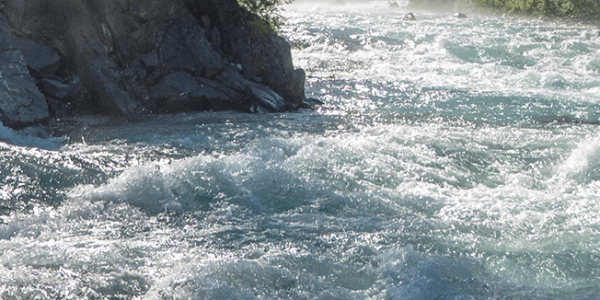Whitewater rafting guests often ask for help in interpreting whitewater difficulty ratings of 1 to 6 that they see in brochures, on commercial rafting company websites, and online when researching a future whitewater rafting trip. Sometimes the rapid classifications will be shown with Roman Numerals (I-VI), but for the purposes of this article, we will use cardinal numbers, 1-6. The information below will help explain where rapid classifications come from and what they mean.
The international scale of river difficulty is an American system used to rate the difficulty of navigating a stretch of river or a single rapid. The scale was created by the American Whitewater Association to evaluate rivers throughout the world. The scale is very helpful as a guide for new whitewater rafting enthusiasts looking to run rivers that they have not challenged in the past.
Crab Apple Whitewater Rafting and many of our individual white water staff and river rafting guides are members of American Whitewater, “a national non-profit organization with a mission ‘to conserve and restore America’s whitewater resources and to enhance opportunities to enjoy them safely.”’
Beginner and Intermediate Rafting Trips
Raft trips are generally considered to be “Float trips” if they mostly encounter Class 1 rapids. AW describes Class 1 as: Fast moving water with riffles and small waves. Few obstructions, all obvious and easily missed. These trips are perfect for first-time rafters or anyone that wants a less strenuous trip.
“Mild” whitewater raft trips for novices and groups with younger children may include just Class 1 and Class 2 rapids, defined as: Straightforward white water rapids with wide, clear channels which are evident without scouting (checking out the rapids from along shore before running the rapid). Occasional maneuvering may be required, but rocks and medium-sized waves are easily missed by trained paddlers.
An “intermediate” raft trip will likely include Class 1, Class 2, and Class 3 rapids. Class 3 rapids are more involved and are defined as: Whitewater Rapids with moderate, irregular waves which may be difficult to avoid. Complex maneuvers in fast current and good boat control in tight passages or around ledges are often required; large waves or strainers (obstructions such as tree branches that allow water, but not solids to pass through them in the river) may be present but are easily avoided. Strong eddies and powerful current effects can be found, particularly on large-volume rivers. Injuries while swimming are rare; self-rescue is usually easy but group assistance may be required to avoid long swims. White water rapids that are at the lower or upper end of this difficulty range are designated “Class III-” or “Class III+” respectively.
Advanced and Extreme Rafting Trips
Looking for a serious whitewater rafting adrenaline rush? Look into rafting adventures with Class 4 or Class 5 rapids. Of course, these river rafting trips will also include Class 1, 2, and 3 rapids, but the feature rapids will be very challenging. Wow, these descriptions make them sound gnarly … but they can be awesome if navigated properly! Class 4 rapids: Intense, powerful but predictable whitewater rapids requiring precise boat handling in turbulent water. Depending on
the character of the river, it may feature large, unavoidable waves and holes or constricted passages demanding fast maneuvers under pressure. Whitewater rapids may require “must” moves above dangerous hazards. Risk of injury to swimmers is moderate to high, and water conditions may make self-rescue difficult. Group assistance for rescue is often essential but
requires practiced skills. Class 5 rapids: Extremely long, obstructed, or very violent white water rapids which expose paddlers to added risk. Drops may contain large, unavoidable waves and holes or steep, congested chutes with complex, demanding routes. White water rapids may continue for long distances between pools, demanding a high level of fitness. At the high end of the scale, several of these factors may be combined. Scouting is recommended but may be difficult. Swims are dangerous, and rescue is often difficult even for experts. Proper equipment, extensive experience, and practiced rescue skills are essential. Because of the large range of difficulty that exists beyond Class IV, Class 5 is an open-ended, multiple-level scale designated by class 5.0, 5.1, 5.2, etc… each of these levels is an order of magnitude more difficult than the last. For example: increasing difficulty from Class 5.0 to Class 5.1 is a similar order of magnitude as increasing from Class IV to Class 5.0.
Finally, we have the Class 6 rapids. Rafting guests love to ask their River Rafting Guide if they “have ever tried a Class 6”. Most Guides will say no, they love whitewater thrills but only up to the point that they feel safe and confident on the river. Class 6 is defined as extreme and exploratory. These runs have almost never been attempted and often exemplify the extremes of difficulty, unpredictability, and danger. The consequences of errors are very severe and rescue may be impossible. For teams of experts only, at favorable water levels, after close personal inspection and taking all precautions. After a Class VI whitewater rapids have been run many times, its rating may be changed to an appropriate Class 5.x rating. There you have it, Class 1 through 6 whitewater rapids explained. Hopefully, this helps you understand the International Scale more clearly and helps you choose your next rafting adventure. See you on the River!!
